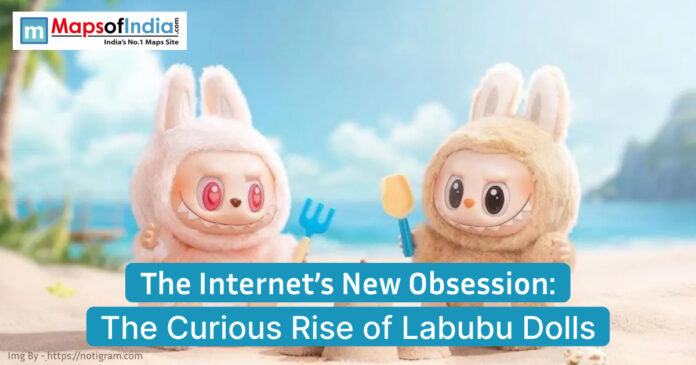Living in an era of rapidly changing trends, it was only a matter of time before social media was taken over by one strange-looking, wide-eyed character: the Labubu doll. Labubu, with its funny-grinned face, big ears, and devilish character, is the doll that also became a cult. You might have come across a Labubu or two by looking through TikTok, turning the pages of Instagram stories, or just lurking on collector forums.
This is where I ask the question: how did they come to be the internet craze? What is so valuable about them that both collectors and the mere fans of certain sports are literally rampaging to acquire them? Why hath Labubu the magic power to resist? So, it is time to explore the crazy world of Labubu dolls and see why people all over the world are falling in love with such a naughty creature.
What Are Labubu Dolls?
Labubu dolls are The Monsters, a series of designer toys produced by Hong Kong-based art studio Kasing Lung x Pop Mart. These dolls are the vinyl figures with a combination of cuteness and creepiness into one, which is commonly called kawaii horror.
The main character is called Labubu, a naughty little creature that has jagged teeth, large eyes, long ears, and a curious expression resembling howling and cute simultaneously. Compared to your ordinary pillow-looking plush or cartoon character, Labubu appears to be a story all in itself, wordlessly. The different editions of the dolls have their various personalities; whether they are pirate Labubu or forest spirit Labubu, so the collectors get to venture into an entirely new world with narratives.
The Origins: A Collab that Clicked
Kasing Lung is a renowned Hong Kong illustrator of a whimsical and surreal style who created the Labubu. Labubu initially appeared in his drawings, which can be characterized as a mixture of dark fantasy and children’s wonder. The move proved brilliant when Lung collaborated with Pop Mart, the main toy brand in China that deals with blind-box collectables.
Pop Mart aids in the transitioning of Labubu, the character, out of paper and into life as a 3D collectable, as depicted in limited edition Vinyl Figures. The dolls come out as seasonal sets, sometimes containing unknown, rare editions that create excitement (and bidding wars) among collectors.
The Blind Box Craze
The so-called “blind box” format is one of the factors that have made Labubu so popular. Before opening the box, you do not know what version of Labubu you are going to receive, so it contains some element of surprise and fun. It becomes a lottery system which turns people who normally would never buy more of a product because they are casual buyers into repeat customers who want to complete a set or get the hard-to-find special edition.
It is a psychological game and works on the same area of the brain that gets a kick out of any scratch card or Pokémon pack. The feeling of anticipation, creative packaging, and the fact that the collector can and will strut about town boasting “everyone has her Labubu dolls”-creates a scenario where the collecting of Labubu delights is simply addictive.
Social Media Fuel: TikTok, Reels, and Unboxing Magic
Labubu dolls have emerged during a period of popularity in unboxing videos provided on platforms such as TikTok and YouTube Shorts. Artists, influencers, and ordinary users are recording the opening of their blind boxes, being excited, reacting, and showing their unique finds.
On TikTok, the hashtag #Labubu has been viewed millions of times, encompassing everything from aesthetic shelf tours and trading help to DIY dioramas of the dolls. Labubu has rapidly evolved into a way of life or design. Its eccentric shape attracts indie art lovers, streetwear adherers, anime-culture aficionados, and even gothic fashion fans.
Much of the obsession is also caused by FOMO (fear of missing out). Most of them are limited editions and edition-wise as well as region-wise, so once they are over, they are over. Every time new drops are on sale, collectors camp online to capture the drop, and the resale prices on eBay or StockX alone can hit a price of 10,000 Rs or more ($120) and up per one rare Labubu.
Why Labubu? The Allure Behind the Doll
Labubu, on the surface, might not be seen as an internet heartthrob. It is not as traditionally cute as Hello Kitty or Funko Pop. That is its magic, however.
Labubu is a combination of the past and its sharpness. Its somewhat gruesome aspects, such as spiny teeth, disquieting proportions and twisted facial expressions, are contrasted with a pool of other regular, idealized characters. It is piggybacking on the so-called ugly-cute aesthetic, so much like finding Gremlins, Coraline or a Tim Burton character aesthetic appealing. It is adorable and with a difference. strange, but lovable. Weird, and yet recognizable.
The doll is also androgynous and is racially unspecific, hence appealing to all cultures and ages. It does not shout gender or background, it is just, and people can superimpose their personalities and emotions.
A Global Community of Collectors
Labubu has spawned an online collection with a world career that has stretched from Japan and Korea to France, India, and the United States. The fans can:
- Sell pieces and trade pieces
- Display wholesome collections
- A cooperative custom diorama
- Pencil fan art and Animation
- Have Labubu meetups or swaps
The community is also uncharacteristically friendly. Compared to certain fandoms that may be gatekept or otherwise intimidating, many Labubu lovers have discussed the scene as inclusive, warm, and motivating to creativity. Lots of people post information about how to determine fakes, how to keep figures in good condition or even how to make their own mini accessories.
The Dark Side: Scalpers and Fakes
With any internet phenomenon, Labubu has not come without its fair share of sunshine or rainbows. In spite of this popularity have been problems with scalpers, who purchase the products as soon as they are released and subsequently resell them at artificially inflated prices. Secret versions or exclusive Labubus of festivals can be sold at a lot (3-10 times) more expensive than their prices online.
Markets are also starting to flood with fake Labubu dolls, particularly on unofficial websites and shops. These fakes are usually visually similar; however, they cannot match originals in terms of quality and materials. Pop Mart has countered this by including QR code verification and better packaging to deal with fakes, yet it is a perpetual fight.
More Than a Toy: A Piece of Pop Culture
Labubu is not a simple toy; it is turning into a pop icon. Labubu has gone beyond collector circles to making their appearance in mainstream culture in collaborations with fashion brands, to the appearance of feature walls during art shows. In Asia, some cafes even decorate with a Labubu theme and offer drinks associated with the character; fashion opinionators also wear items inspired by the character.
Big brands are paying attention even to this. Even bigger than toy merchandise is the possibility of Labubu merchandise without Pop Mart, though, with reports that clothing, household items and even animated shorts are being developed.
Conclusion: A Monster-Sized Moment
Labubu dolls have created a niche of their own in the overcrowded market of internet obsessions, half craft object, half plaything, half cultural manifesto. Even with its eccentric aesthetics, the buzz of collectable delight, and having a vibrant community of supporters that can be found all over the world, Labubu is not a short-lived fad. It is a celebration of the strange, beautiful, and quirky in the world that is too perfect and cliché.
And whether you are a long-time collector or you just came across a TikTok unboxing video, there is one thing certain: when Labubu peeps his curious little smile at you, you will be lost.




